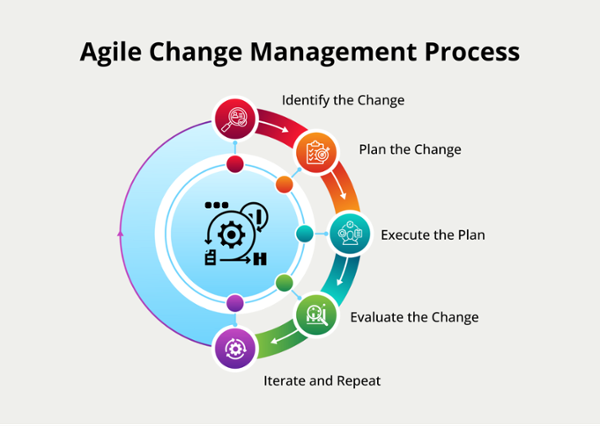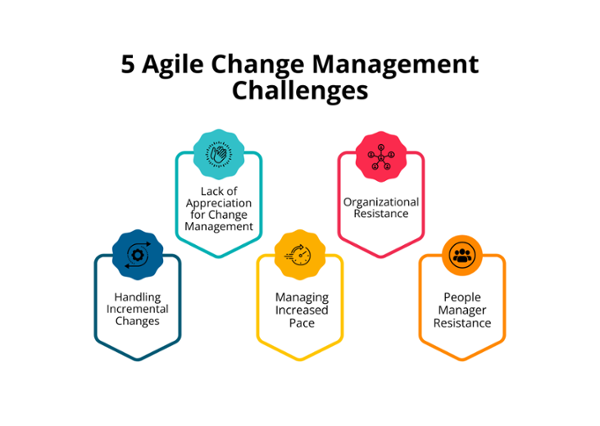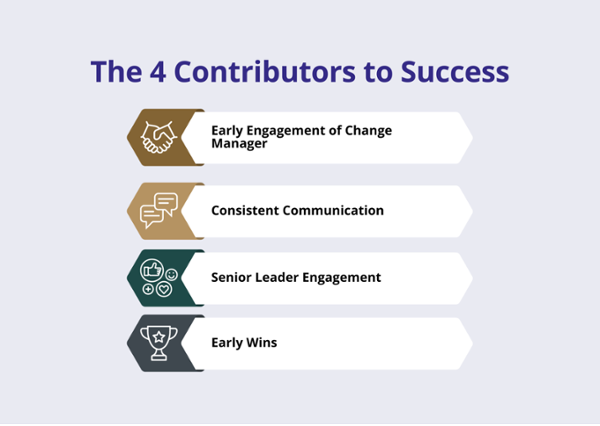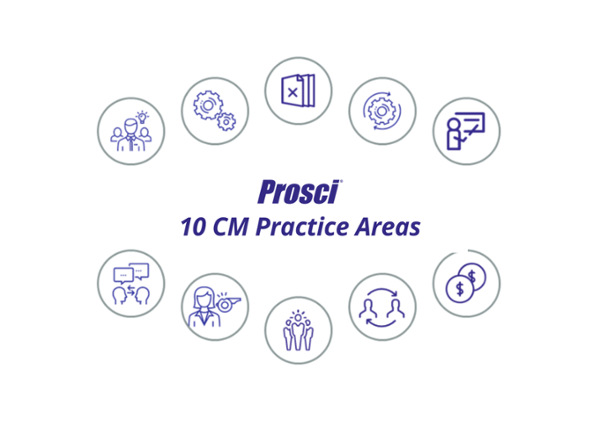Agile Change Management: Valuable Insights for Project Adaptability

7 Mins
Updated: October 22, 2025
Published: February 1, 2024

Agile change management is essential when working on complex projects. It follows the Agile Manifesto's value of welcoming change, which is great for projects with many connected parts and changing situations.
Agile is famous for being flexible and allowing for easy adjustments during a project. This is important because strict plans don't work well with quick changes.
Prosci is well-known for change management skills and combines Agile with traditional change management, improving efficiency and helping organizations grow.
We developed the Change Management and Agile Report based on this innovative approach. It provides practical methods for using Agile to achieve significant results.
We'll explore the report to help you understand the nuances of Agile change management and discover how to use this approach to manage change in your business.
What is the Difference Between Agile Change Management and Agile Methodologies?
Agile methodologies, rooted in the Agile Manifesto, are principles and practices used in project management and software development, emphasizing incremental work delivery, collaboration and rapid adaptation. This approach has successfully expanded from its software development origins to various fields in all kinds of businesses.
Shifting from the broader scope of Agile methodologies, Agile change management focuses on managing organizational change flexibly. It strongly emphasizes the human aspect of change, supporting individuals and entire organizations as they adapt to new processes and strategies.
This approach applies across various organizational changes, extending well beyond software or project development.

Understand the Agile Impact on Transformation and Change Management
“In a project using an Agile method, change management must adapt and be flexible.”
— Tim Creasey, Prosci Chief Innovation Officer
The volume of chatter about Agile and change management continues to rise. However, direction on integrating change management with Agile methods has been harder to come by. Prosci conducted benchmarking research to uncover insights, experiences and expertise from change practitioners with a foot in each discipline to understand the intersection of these critical disciplines, culminating in the Change Management and Agile Report.
Let’s look at the report's different sections and what they entail.
Agile transformation: Manage the people side of change
This section of the Change Management and Agile Report sheds light on critical elements, including the human aspect of change in an Agile transformation, emphasizing:
- Systemic introduction of Agile as a methodology
- Effective strategies for managing the workforce aspect of this transition
- Critical practices in supporting and guiding professionals and individuals through the Agile adoption process
These three areas form the bedrock of successful Agile implementation, focusing on the often-overlooked human element in such transitions.
Adapting change management to Agile projects
This part of the report addresses how to adapt and refine change management practices. Key insights include:
- Tailoring change management approaches to fit Agile's dynamic nature
- Ensuring change initiatives align with Agile's rapid delivery cycles
- Emphasizing continuous engagement and feedback loops in managing change
The section on adapting practices for Agile project environments underscores the importance of customizing methodologies to Agile's lively pace, aligning initiatives with quick delivery, and prioritizing ongoing engagement and iterative feedback for effective management.
Insights and adaptations for Agile change management
Now that you understand the report's key findings, let's explore their practical application in terms of:
- Integrating change management within Agile frameworks effectively
- Recognizing the distinct challenges and opportunities presented by Agile environments
- Understanding that the adaptability and expertise of practitioners are central to the success of Agile change management and that change professionals must possess:
- Experience navigating the Agile change management landscape
- Ability to tailor change management strategies to specific organizational
needs - Adaptability as a vital success factor in Agile change management
Agile and Iterative Change Management: A Symbiotic Relationship
When applying Agile approaches, it becomes imperative for change practitioners to maintain core change management principles while recalibrating strategies.
Deep dive into Agile's influence on change management
Let’s examine how Agile creates a fresh perspective on change management.
- Iterative approach – Prosci concepts fit into an Agile framework. Rather than reinventing strategies with each sprint, the focus is on refining and adapting them, drawing on continuous learning and feedback.
- Adaptive planning – Change management plans require a program based on real-time learning and feedback to stay responsive and aligned with the Agile process.
- Early strategy – Agile methodologies allow us to understand the change impacts early, foresee potential resistance points and craft an engagement strategy.
- Quick change management – Short, impactful communications, targeted training sessions, and rapid response mechanisms help you to manage change and keep pace with Agile's quick iterations.
An Agile outlook steers us to look at change management differently.
Refine change management in Agile
Supporting Agile with change management means being as adaptable and dynamic as the methodologies themselves.
The Prosci Change Management and Agile Report provides practical guidance and best practices. This report skillfully blends the fast-paced nature of Agile with the effectiveness of change management to leverage both strengths.

What Are the Common Obstacles When Bringing Change Management to an Agile Project?
To bridge the gap between Agile's compelling story and how it operates, change managers should outline how each sprint affects current business processes and the adjustments required.
Common Agile change management challenges and solutions
Study participants identified five common obstacles when bringing change management into a project using Agile iterative development processes:
- Lack of appreciation for change management – Change managers should educate stakeholders on how change management can enhance Agile projects. This could involve workshops, case studies, and demonstrating ROI (return on investment) from successful change initiatives.
- Organizational resistance – Change managers, people leaders and project sponsors should offer transparent communication about the benefits of Agile for employees to transition smoothly.
- Handling incremental changes – Change managers should provide clear documentation, training and support structures.
- Managing increased pace – In a fast-paced, Agile project, change managers must collaborate closely with Agile professionals and those impacted, providing succinct updates and regular check-ins for smooth progress.
- People manager resistance – Engaging middle managers early and involving them in planning can help mitigate resistance. Change managers should provide professionals with specific training on Agile's benefits and their role in the change process.
A successful transition should effectively combine strategic direction with practical operational execution. It should build support and buy-in at all levels, from the C-suite to front-line employees.

What Are the Greatest Contributors to Success When Integrating Change Management and Agile?
In Agile projects, focusing on and celebrating every small success is important. A good approach is planning short sprints, where each achievement is seen as a win, no matter how small. This approach helps everyone stay committed and contributes to the project's success.
Look at four successful contributors when applying change management using an Agile approach:
- Early engagement of change manager – A change manager’s expertise ensures that the human aspects of change are just as important as the technical elements.
- Consistent communication – The frequency and clarity of communications keep everyone, from the development team to the end-users, in sync with the project's progress and changes.
- Senior leader engagement – Senior leaders’ involvement lets the organization know that the project is a priority and creates resources to support a smooth transition.
- Early wins – Identify and celebrate early wins, no matter how small, and prove that the change is moving in the right direction. These wins act as milestones that encourage continued engagement and action.
So now let’s explore how these key factors are crucial in deepening stakeholder engagement throughout the Agile change management process.
Deepening the understanding of engagement
Integrating change management into Agile is essential because it meshes well with Agile's own rules. The Agile coach guides from the outside, but the real success comes when change management is a direct part of the Agile team, driving the project forward effectively.
The Product Owner should include change management tasks in the project backlog. Doing this ensures that the successful adoption and use of new systems or processes are part of the project plan, directly contributing to the project's success and enhancing its return on investment.
In contrast, the Scrum Master must prioritize change management and keep everyone on track.
It's important to keep employees engaged by:
- Talking with them regularly
- Listening to their feedback
- Including them in creating solutions
This approach fosters a culture where change is collaboratively embraced rather than imposed.
Agile Change Management in Enterprises

Agile extends past software and IT projects to include non-IT projects. Within an enterprise project using Agile, change management can support accurate results. The following case study showcases Agile adaptability.
Agile Change Management at Microsoft With Prosci Expertise
In partnership with Prosci, Microsoft has adeptly aligned Agile change management with current IT project management trends, utilizing methodologies like Scrum and SaFe.
Impactful scenarios:
- Hybrid methodologies in practice
Microsoft skillfully merged Agile with a waterfall model for a European material handling company to develop a technician app, integrating a structured change management approach from Prosci for a balanced methodology. - Facilitating digital transformation
In a renewable energy company's digital shift, Microsoft worked within Scrum Teams, with strategies enhancing Agile coaching and user adoption from Prosci. This collaboration ensured the seamless integration of effective change management with Agile processes. - Guiding major organizational shifts
Assisting a car manufacturer in transitioning to a cloud-native IT platform, Microsoft applied change management insights from Prosci to navigate the shift from legacy systems, focusing on operational and cultural adaptations.
Microsoft's approach, enriched by change management principles from Prosci, is tailored to each client's unique needs, balancing technical agility with a focus on the human aspects of change.
This partnership underscores the effectiveness of combining technical and change management expertise in Agile environments.
How Do the Practice Areas of Change Management Look Different in an Agile Effort?
Prosci took an innovative approach to uncovering specific direction and guidance for change practitioners working to adjust their work in an Agile environment. We began by identifying 10 change management practice areas to investigate:
- Sponsorship
- Approach
- Resources
- Integration of change management and project management
- Employee engagement
- Communications
- Manager engagement
- Training
- Resistance management
- Reinforcement
For each of the ten practice areas, we collected data from study participants on:
- Challenges faced when applying that practice area in Agile
- Adaptations made when applying that practice area in Agile
- What to do differently the next time for that practice area in Agile

The full Change Management and Agile report has complete write-ups on each of the three questions for all ten of the practice areas.
For this blog, we’ll provide a short solution for each of the ten practice areas below:
|
|
Practice area |
Solutions |
|
|
1. Sponsorship |
An impactful method for sponsors to fulfill their role effectively is through participation in end-of-sprint demos. These sessions provide a window into the Agile team's progress; they are a platform for sponsors to practice the ABCs of sponsorship—Actively and visibly participating, Building a coalition, and Communicating directly. |
 |
2. Middle Manager |
As a project progresses, middle managers transition from traditional tactical oversight to more of a coaching and facilitative role. This shift is pivotal in empowering professionals to make decisions that align with Agile principles. |
 |
3. Employee Engagement |
Regular, informal check-ins and collaborative platforms become vital for real-time, continuous dialogue. This approach allows employees to contribute ideas and feedback spontaneously, aligning with Agile's fast-paced nature. |
 |
4. Approach |
A key aspect of aligning change management with Agile methodologies is incorporating “Change Management User Stories” into the product backlog. This approach prioritizes change activities effectively, based on the current phase of the Agile cycle. |
 |
5. Resources |
Resource flexibility is paramount, particularly in change management. When change management professionals join the Agile team, they assume the role of a "Developer," focusing primarily on Change Management User Stories. |
 |
6. Integration With Agile/Project Management |
Maintaining integration between change management and Agile/Project professionals is crucial, which requires shared tools and dashboards. These platforms facilitate transparency and collaboration, which are essential for the Agile process. |
 |
7. Communication |
Communication should be tiered, customized and scaled, ensuring that different stakeholders receive information tailored to their needs and level of involvement in the project. This strategy prevents information overload and enhances engagement. |
 |
8. Training |
Adaptability in training methodologies includes just-in-time training, often utilizing modules designed to be accessible on-demand for immediate and relevant learning experiences. |
 |
9. Resistance Management |
Resistance management plans can be done as resistance sprints. These are focused periods during which networks proactively address concerns and feedback from recent changes. |
 |
10. Reinforcement |
Reinforcement strategies are evolving to include gamification techniques. This ensures that employees receive immediate recognition for adopting new practices that align with the Agile change. |
Agile Change Management: Shape Tomorrow’s Success
Agile change management is used for organizations adapting to fast-paced changes, extending beyond IT to various industries.
It simplifies and improves the process of managing change.
Prosci helps as a guide, particularly for complex enterprises, helping networks adapt and thrive using Agile's flexibility. Are you ready to elevate how your organization handles change?
Discover the transformative impact of Agile change management in your industry with guidance from the Prosci Change Consulting and Advisory team. Our experts are equipped to facilitate smoother transitions and foster team engagement, helping you navigate toward an adaptive and successful future.





